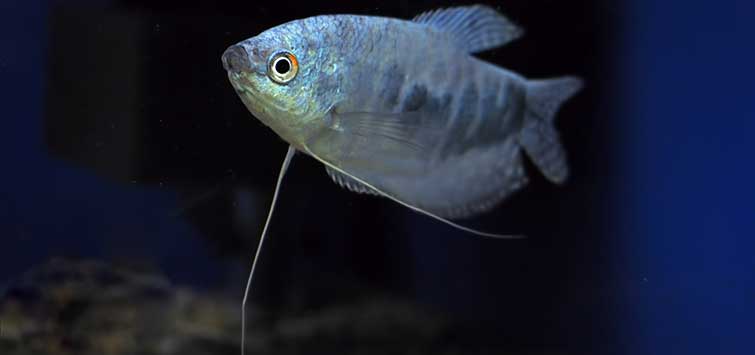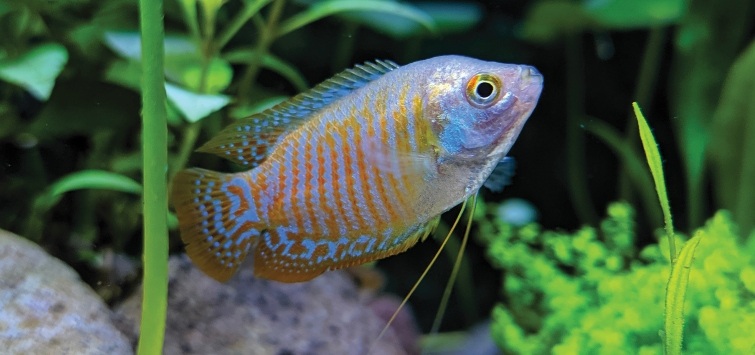Grand & Glamorous Gouramis
Joshua Wiegert
Aquarium fish can be roughly divided into three categories. First, there are your utility fish, which are those that you add to an aquarium to fulfill a function, such as a group of Otocinclus to help with algae or a pod of loaches to control a pest snail outbreak. Hopefully, you like these fish, but the main reason you picked them is because they “do” something.
Second are your filler fish—groups of tetras, barbs, or whatever that swim around and fill space. This is where most aquascaped tanks stop. They’ve got some cory cats, some Amano shrimp, and a big school of harlequin rasboras, and that’s it.
The last category is feature fish, the bigger occupants that are the main focus of the aquarium. Often, tanks are built around kribensis, discus, or other cichlids. However, gouramis are another great choice for feature fish too often overlooked by aquarists.
Gouramis are members of the anabantoids, a group of fish best known among hobbyists because of the common betta, a not-so-distant cousin. They’re found throughout most of South Asia and, especially, Southeast Asia. Most species of gourami are quite small, and while we might set up a nano tank around them, here we’ll focus on the handful that are larger and could be the central focus of an average aquarium.
Most of these are in the genus Trichopodus. There are a half-dozen species in the genus, with four commonly seen in the trade (and I don’t believe I’ve ever even seen the other two). They’ll get to about 5 or 6 inches (12.5 to 15 cm) at most when fully grown.
Gouramis are found in slow-moving, heavily weeded bodies of water, such as small ponds, swamps, and especially rice paddies. This environment is not so dissimilar to what many planted aquariums are, or most aquariums in general. Their natural diet is primarily insect larvae and zooplankton, but, in the aquarium, any solid flake food will do. Most gouramis will do well in soft, acidic water, but these common species have been captive-bred for generations and are especially adaptable. Provided you’re not putting them in liquid rock, they’ll be just fine.
Anabantoids are also known as labyrinth fish. They have a labyrinth organ that allows them to breathe atmospheric air. In fact, most gouramis can survive out of water indefinitely, as long as they don’t dry out.
Oddly enough, many species are obligate air breathers, meaning that they must breathe atmospheric air; if they don’t have access to the surface to get a gulp regularly, they’ll drown. This adds an interesting concern for keeping them—not only is water quality important, but so, too, is air quality.
Gouramis should not be kept in environments where there is usually significant contamination. Smokers may have trouble keeping gouramis, as will people who love air fresheners or spray insecticide at the first glimpse of a spider. Similarly, they shouldn’t be kept in the kitchen.
One of the most striking features of a gourami is its long, elegant “feelers.” They’re extended portions of the pelvic fins, and the fish extend them while swimming. Like a cat uses its whiskers, gouramis extend their feelers every which way to feel objects in the aquarium. They can use them to sense food and will often check out other fish with them, especially other gouramis.
These long feelers, as well as the length of the other fins, do limit tank mate selection. Nippy fish should never be housed with gouramis. Many barbs and aggressive tetras will make short work of the feelers, as well as their other fins.
While gouramis are mostly peaceful, other anabantoids are a no-go, as aggression between similar species may occur. Mixing the different species of Trichopodus is usually okay, provided you have plenty of room in the tank and lots of plants and structure breaking up lines of sight.
I like to mix gouramis with other fish from Southeast Asia, especially the various rasboras. The harlequin type rasboras work well, with one caveat. Fully grown harlequins are fine with fully grown gouramis, and the small rasboras you buy at the aquarium store will be fine with the gouramis you just bought, too, but adding more rasboras down the road will be a challenge.
Clown rasboras are another great addition, though they can be hard to find. They’re generally a lot bigger than harlequins. Most of the larger danio species (like the giant danio), rainbowfish, and full-bodied tetras will all work well, too. Most bottom-dwelling fish will be utterly ignored.
Let’s meet the four Trichopodus species—and a few color morphs—most commonly found in the aquarium trade.
The Three-Spot Gourami
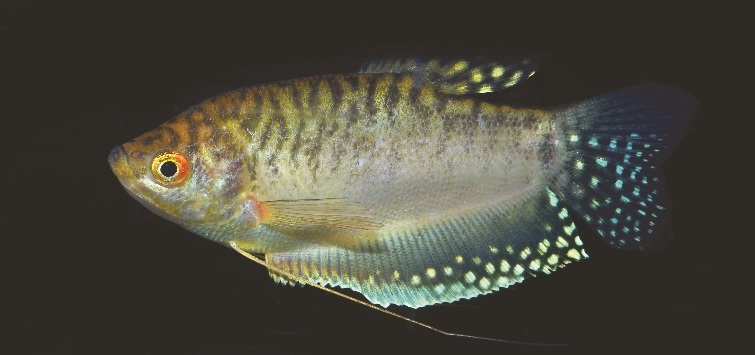
The pattern on all of the various types of three-spot gourami vary greatly, but you’ll likely drive yourself mad trying to figure out why they’re called “three-spot” gouramis. Try as you might, you’ll only count two spots on the body. The third spot, giving it the name, is apparently the eye.
The best known of these is the blue gourami, a beautiful light-blue fish. A mottled
Less commonly, you might see the mostly all-white variety called a platinum gourami. A purplish morph called the lavender gourami looks, to my eye, the closest to the natural wild form. Interestingly, it’s often the result of crossing a gold gourami with either a blue or opaline!
These five gourami types are all the same species of fish and just vary in color. They’ll reach about 6 inches (15 cm) in the aquarium, though they’re often sold at a fraction of this. Of the common gourami species, I’ve found the three-spot to be the most aggressive, with fish frequently bickering amongst each other.
Your best bet is to keep only a pair, either a single male and a female, or two females. If the tank is very large and has plenty of structure in it, you can possibly keep more.
The Pearl Gourami
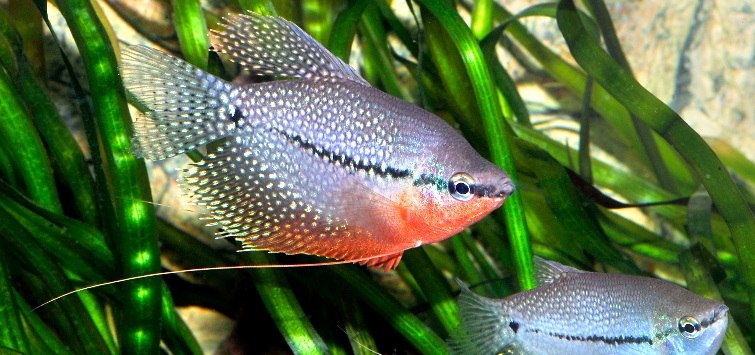
The pearl gourami (T. leerii) is a close second in popularity to the three-spot gourami, and, if not for the combination of the numerous morphs, it would be the most popular. Also known as the lace gourami, and the leerii gourami (sometimes erroneously spelt with a single i), this is the most beautiful of the Trichopodus species—and frankly, I think that it is the most beautiful of all gourami species.
The body is a reddish-brown covered with white pearls or lace. In adult fish, especially males, the throat, chest, and much of the lower body are bright red. When breeding, this bright red intensifies to an almost unnatural level. These fish tend to be fairly plain in the store, so definitely take them home, let them settle in, and allow them to grow a bit more. On paper, this is a slightly smaller fish than the three-spot gourami, reaching about 5 inches (12.5 cm). However, I’ve seen them a little bigger, so your milage may vary on maximum size.
These are one of my personal favorites. They’re beautiful, hardy, and striking, and they occupy the upper portions of the aquarium, an area all too often forgotten by aquarists. Males can be aggressive toward one another, but, otherwise, this is a very peaceful fish, and I’ve found them to be easy to breed.
The Moonlight Gourami
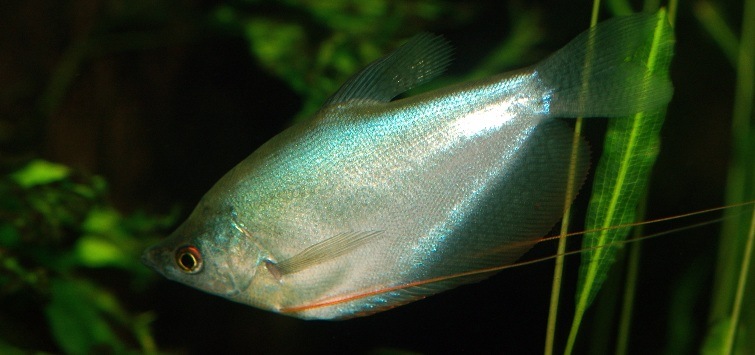
The moonlight gourami (T. microlepis) is a beautiful fish, if lacking somewhat in color. The overall body is silvery gray, leaning toward white. Typically, they are quite ugly in the aquarium store, but, when they settle in, the reflective, almost iridescent patterns of the body really start to shine—literally.
The feelers, and sometimes part of the chest, are bright red in mature males. Otherwise, the two sexes are identical, and this is really the only hint of pattern beyond the silvery moonlight body. They’re a subtle but striking fish in the aquarium.
Moonlights are slightly smaller than the three-spot gourami, reaching only about 5 inches (12.5 cm) or so in the aquarium. I’ve found them to be perhaps a little less hardy than the three-spot, but they’re also quite a bit more peaceful.
The Snakeskin Gourami
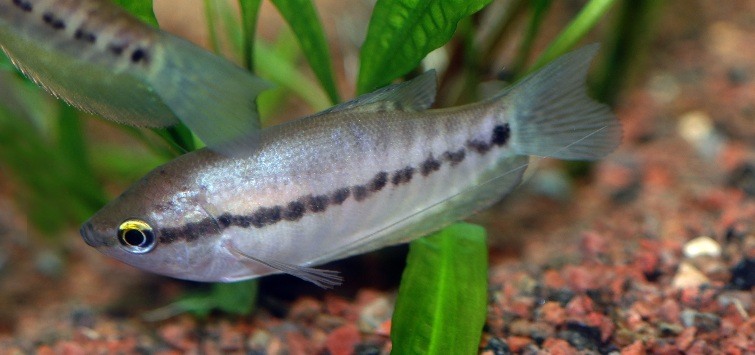
The snakeskin gourami (T. pectoralis) looks similar to a three-spot gourami, with a very similar pattern. However, they lack the spots. They’re probably the least common of the four common species, perhaps owing to their much larger size.
Wild fish are known to reach nearly a foot (30 cm), though aquarium fish tend to be similar in size to the three-spot, about 6 inches (15 cm). Its large size does make it one of the most commercially important gourami species in Southeast Asia, where they’re commonly aquacultured for the dinner table.
Despite their much larger size than the other four members of the group, I would rate them as the least aggressive. Larger adults may bicker with each other in a smaller tank, but, otherwise, they do quite well.
Breeding Gouramis
Like their familiar betta cousin, gouramis are bubblenesters. Males and females are a touch more challenging to tell apart than in the betta, though. Males are usually more brightly colored and slimmer, and, when mature, have pointed dorsal (top) and anal fins, whereas females are usually easiest to pick out by their rounder belly.
They can be bred in a special breeding tank, and the formula for doing that is essentially identical to breeding bettas. They’ll also often breed in a planted, community tank. The male will construct a bubblenest, frequently using bits of floating plants. This looks like a layer of foam on the top of the water, usually in the quietest portions of the tank, away from water flow.
A female will enter underneath the bubblenest, and the two fish will begin a long, involved mating ritual. Typically, this involves a lot of caressing with their long feelers and ends with the pair wrapped around each other.
The eggs float, and the male places each one into a bubble. At this point, he becomes very protective of his nest and territory. If they’ve spawned in a community tank, you will certainly want to carefully remove the female and any other gouramis, and possibly the other fish. (Or, if you’re not interested in fry, you can just swish the nest with your net a few times. The male will usually settle down quickly once the nest is lost.)
The number of eggs will depend on species. Pearls, three-spots, and moonlights will lay a couple hundred eggs, while snakeskins may lay thousands (perhaps one of the reasons they’re such a popular food fish). The eggs typically hatch in a day or two, and the male continues to guard the fry in the nest for up to a week.
They’ll hang up at the surface of the water and should be fed infusoria or liquid fry food. If there are other fish in the tank, including the male gourami, very few are likely to survive to adulthood.
Note that if you do wish to raise the fry, aside from removing predators, you must carefully monitor your air quality until they’re mature. The layer of air above the aquarium must be humid, warm, and clean. This is typically best accomplished by lowering the water level in the aquarium significantly and maintaining a tight (though not too tight) lid to trap humidity.
Fantastic Feature Fish
So, what are you going to build your next tank around? Another planted tank built up around some apistos or kribensis? Just a big school of neon tetras? Sure, those are pretty and fun, but—especially if you’ve got a larger tank—a big, nice feature fish can be found in the common gourami species. Often overlooked by aquarists, these are beautiful fish that add a new dimension to the aquarium, traveling throughout not only the middle levels of the aquarium, but also to the upper levels as well.

.png?h=595&iar=0&w=2781&hash=5FD5E69473BCC22199FBFA2FB71B6033)


